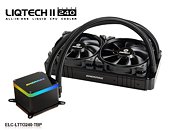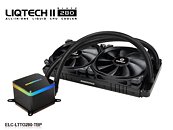Wednesday, December 5th 2018

ENERMAX Launches LIQTECH II, Universal AIO Liquid Cooler with TDP 500+ Watts
ENERMAX, a leading designer and manufacturer of high-performance PC hardware products, announces the launch of a new all-in-one liquid cooler series, LIQTECH II. Responding the market demand of cooling solution for high-end CPUs, LIQTECH II can deliver enthusiast-grade cooling capacity of 500+ watts (TDP) and is compatible with both Intel and AMD sockets (except AMD sTR4).
Furthermore, certified by main motherboard makers (ASRock, ASUS, Gigabyte, and MSI), LIQTECH II can support the latest addressable RGB lighting synchronization with advanced motherboards featuring addressable RGB headers (pin assignment: 5V/D/-/G) to create dynamic visual effects. LIQTECH II is perfect for overclocked systems, image editing workstations, and high-end gaming machines.Extreme High Cooling Capacity of TDP 500+ Watts for Intel and AMD CPUs
LIQTECH II, a universal Intel and AMD CPU cooler series, has extremely high cooling capacity of TDP 500+ watts, which can also easily handle a large amount of heat generated by the heavily overclocked CPUs. Thanks to ENERMAX patented SCT (Shunt Channel Technology) cold plate design to deliver 30% more heat exchange efficiency, LIQTECH II can offer superior, reliable cooling performance. Besides, LIQTECH Il comes with the powerful ENERMAX EF1 pump, equipped with a high-efficiency ceramic nano PI bearing, can produce high flow rate up to 450 L/h, which is 7 times stronger than its peers.
Premium Addressable RGB Water Block
The water block of LIQTECH II features a premium acrylic cover and a vivid Aurabelt, an exquisite LED lighting design to provide unique visual experience. Moreover, LIQTECH II offers 2 ways to control the RGB lighting effects. Users can program preferred lighting via RGB motherboard software to match the colors with other RGB components. Or, users can use the included control box to select preferred lighting effects (10 pre-set effects), colors, brightness and speed.
LIQTECH II series comes in 3 different radiator sizes: 360, 280 and 240mm; meanwhile, the new lineup also has a special edition of 360mm radiator in white. LIQTECH II includes universal mounting kits, supporting the latest sockets of Intel (LGA2066/2011-3/2011/1366/1156/ 1155/1151/1150) and AMD (AM4/AM3+/AM3/AM2+/AM2/FM2+/FM2/FM1).
LIQTECH II will be available at retail in early December of 2018.
For more information, visit this page.
Furthermore, certified by main motherboard makers (ASRock, ASUS, Gigabyte, and MSI), LIQTECH II can support the latest addressable RGB lighting synchronization with advanced motherboards featuring addressable RGB headers (pin assignment: 5V/D/-/G) to create dynamic visual effects. LIQTECH II is perfect for overclocked systems, image editing workstations, and high-end gaming machines.Extreme High Cooling Capacity of TDP 500+ Watts for Intel and AMD CPUs
LIQTECH II, a universal Intel and AMD CPU cooler series, has extremely high cooling capacity of TDP 500+ watts, which can also easily handle a large amount of heat generated by the heavily overclocked CPUs. Thanks to ENERMAX patented SCT (Shunt Channel Technology) cold plate design to deliver 30% more heat exchange efficiency, LIQTECH II can offer superior, reliable cooling performance. Besides, LIQTECH Il comes with the powerful ENERMAX EF1 pump, equipped with a high-efficiency ceramic nano PI bearing, can produce high flow rate up to 450 L/h, which is 7 times stronger than its peers.
Premium Addressable RGB Water Block
The water block of LIQTECH II features a premium acrylic cover and a vivid Aurabelt, an exquisite LED lighting design to provide unique visual experience. Moreover, LIQTECH II offers 2 ways to control the RGB lighting effects. Users can program preferred lighting via RGB motherboard software to match the colors with other RGB components. Or, users can use the included control box to select preferred lighting effects (10 pre-set effects), colors, brightness and speed.
LIQTECH II series comes in 3 different radiator sizes: 360, 280 and 240mm; meanwhile, the new lineup also has a special edition of 360mm radiator in white. LIQTECH II includes universal mounting kits, supporting the latest sockets of Intel (LGA2066/2011-3/2011/1366/1156/ 1155/1151/1150) and AMD (AM4/AM3+/AM3/AM2+/AM2/FM2+/FM2/FM1).
LIQTECH II will be available at retail in early December of 2018.
For more information, visit this page.




16 Comments on ENERMAX Launches LIQTECH II, Universal AIO Liquid Cooler with TDP 500+ Watts
I somewhat doubt it.
But i hope reviews prove me wrong.
Its biggest pitfall is the fans. They NEED to improve the fans or reduce the radiator thickness. Even my SP120s mounted to it have issues pushing air through it. (regarding the 240mm version)
They need to go to a push/pull fan setup if they intend to keep the rads that thick.
I had a Corsair H110 on a 9900k with OC 5ghz on all cores (about 185W). it is now under a custom loop and temperatures have dropped by around 15 degrees. Under heavy bench, I went from 90 to 75 degrees. ...And anyway H110 has a 280mm radiator
If you want to get even more fine-grained, it's also worth considering that the silicon in the 9900K is thicker than it was in the 8700K - we've seen temperature reductions when Der8auer sanded down the silicon of the die to make it thinner, so even the silicon itself can cause a bottleneck in thermal performance.
Regardless, if any one of those transfers occurs slowly, the heat will build up at that point and temps will start to increase. If you want the absolute best possible cooling, the thing to do is reduce the number of interfaces and improve their quality - that was the goal behind the Ncore V-1 for example, which was a waterblock that replaced the CPU heatspreader, thus removing an entire layer of thermal paste and a heatspreader from the chain.
Improving the capacity of the radiator will always have an effect because heat transfer occurs slightly faster if there's a greater delta between the temperatures of two objects - if your radiator gets rid of heat faster then it will be colder and the transfer to it will be that slight bit more rapid, but there's a limit to how effective this approach is if there is a bottleneck elsewhere.
On an air cooler, sure, better thermal conductivity in a fin means that the heat is more evenly conducted across the whole fin, and there arent hot spots by the heatpipes and cold spots at the edges.
But in a radiator, no part of any fin is far enough away from the heat source (the water) to be at a measurably different temperature to any other part of the fin. That fact makes alu and copper pretty much identical in terms of performance.
The reason you use copper instead of alu in radiators is to prevent galvanic corrosion, and AIOs have that covered with fluid additives - they can afford to cover it this way because when you build every part of the system, you can also control the material composition of the parts and ensure nothing funky goes on with your alloys, fittings, plating etc.
Its no secret that AIOs don't perform quite as well as open loops, but that's down to almost everything BUT the radiator materials. Thickness, fin density, pump power, cold plate size and fin density, or even just a lower liquid volume in the loop - liquid temp rises more slowly the more liquid there is to heat up in the first place, and very few places test AIOs long enough for loop temperatures to stabilize.
I've never managed to get a nice all white build together yet, too many sacrifices and too little choice to get there...
a) Lower heat transfer efficiency will usally mean bigger fpi.
b) The low efficiency, higher fpi, low pump flow and, eventually crud in the fins from galvanic corrosion, means more oomph needed from fans.But not "in real life"That doesn't explain why the CLCs get trashed by the Swiftech and EK Units. Cold plate size ... on same CPU ? Thickness ... still gotta fit in the case ? Volume ? No significant differences at all between Swiftech / EK units. Yes, of course they often increase fpi and fan rpm... to make up for the decreased transfer efficiency, weak pumps and eventual clogging. The reason they need more surface area and more rpm to even get within 5C of the copper units. is because of the low flow and conductivity.
TPU reviewed the EK MLC Phoenix and it was 3c cooler with a 360mm rad than a fractal celsius S24 - a system with an alu radiator.
An entire extra fan's worth of radiator and it only achieved 3C cooler.
The rest of your post is just barely coherent gibberish.
Alu rads are not appreciably worse than copper ones, all else being equal. The thermal conductivity of one material vs the other does not make heat more efficiently spread over the ~1cm depth of a radiator fin, to a degree that would make a difference.
If your radiator had fins that were 4 inches long, it would make a big difference, but your radiator does not have fins that long, and so the heat does not end up unevenly distributed.